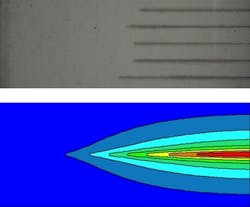RIKEN researchers figure out laser-induced damage to nonlinear optical crystals
Wako, Japan--Upconverting infrared (IR) laser radiation to visible light is important in many applications, including laser surgery and spectroscopy. However, the nonlinear optical crystals used to upconvert light tend to suffer crystal damage at high laser intensities. Oleg Louchev from the RIKEN Center for Advanced Photonics and colleagues have now discovered that such crystal damage arises from small localized temperature rises due to photon absorption and electric-field effects within the crystal.1, 2
“Frequency conversion is often limited by laser-induced breakdown and crystal damage,” notes Louchev. Even if a crystal appears transparent to the naked eye, it will still absorb a significant fraction of the light that passes through. This light is absorbed by electrons in the crystal, which after being excited are accelerated to energies high enough to produce point defects in the crystal lattice. If such processes occur repeatedly, they can lead to macroscopic damage tracks (see figure).
Damage mostly caused by visible light
The damage mechanism uncovered by the research team is also based on light absorption. Most of the energy absorbed by the crystal comes from the higher-energy visible light in the converted laser beam, and not the original IR laser beam hitting the crystal. The visible light intensity ramps up as the IR light passes through the crystal, meaning that more light is absorbed at the back than at the front. This creates a small temperature rise at the back of the crystal. In nonlinear optical crystals, a local temperature rise also causes an electric field in the heated spot. Thus, in addition to the generation of free electrons by light absorption, the electric field accelerates the free electrons, eventually leading to crystal damage.
Louchev and his colleagues verified this damage process through experiments using laser pulses of various intensities. The experimental observations agree with a theoretical model of the damage process. Even though only nanosecond-long laser pulses were used in the experiments, Louchev emphasizes that the observations are generic. “The proposed mechanism and kinetic pathway of breakdown might be involved in a variety of other processes where laser-matter interactions occur in nonlinear optical crystals, and also with laser pulses of much shorter timescales,” he says.
Source: http://www.rikenresearch.riken.jp/eng/research/7611.html
REFERENCES:
1. Louchev, O. A. et al., Applied Physics Letters 103, 091114 (2013).
2. Louchev, O. A. et al., Journal of Applied Physics 114, 203101 (2013).

John Wallace | Senior Technical Editor (1998-2022)
John Wallace was with Laser Focus World for nearly 25 years, retiring in late June 2022. He obtained a bachelor's degree in mechanical engineering and physics at Rutgers University and a master's in optical engineering at the University of Rochester. Before becoming an editor, John worked as an engineer at RCA, Exxon, Eastman Kodak, and GCA Corporation.
